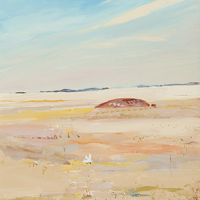ARTHUR BOYD Landscape with White Bird 1990

Boyds aesthetic relied on change and progress. He tended to work in series where he could direct his focus and immerse himself in a project. The drain caused by the intellectual, emotional and physical effort required to paint had to be balanced and so Boyd adopted a pattern of alternating between weighty allegories on one hand and direct uncomplicated landscapes on the other. These reflective paintings provided a means of punctuating his career and performed the function of restoring his aesthetic. When Arthur returns to landscapes he re-focuses. Telescopic visions disappear. There is no distortion, no veil of metaphor, no long looks back through time. Nightmares dissolve under brilliant light and, as claustrophobic crowds disperse and human activity lessens, the view widens.1
The landscape of the Wimmera, the arid agricultural district four hours west of Melbourne, was first encountered by Arthur Boyd as a young man while visiting friends at the town of Horsham in the late 1940s. The unlikely, minimalist topography of the place had already been put on the map as the subject of an extended series of paintings by Boyds friend and contemporary, Sidney Nolan, stationed there while serving with the Australian Army in the early 1940s. The landscape would appear to have offered very little to either artist: with no Kelly myths to draw upon, and a geography that is frankly uniformly flat and featureless. Yet both artists responded strongly to the place and Boyd continued to draw on the subject for the remainder of his long and productive life. The earliest examples, painted in the late 1940s, differ from those painted in his last years only in subtle ways. Through all of the stylistic and technical changes as well as the Byzantine iconographies that we are accustomed to seeing in Arthur Boyds allegorical art, the Wimmera landscapes remain refined and sensitive yet solidly real.
Footnotes
1. Bungey, D., Arthur Boyd A Life, Allen & Unwin, Sydney, 2007, p.247
Timothy Abdallah BA